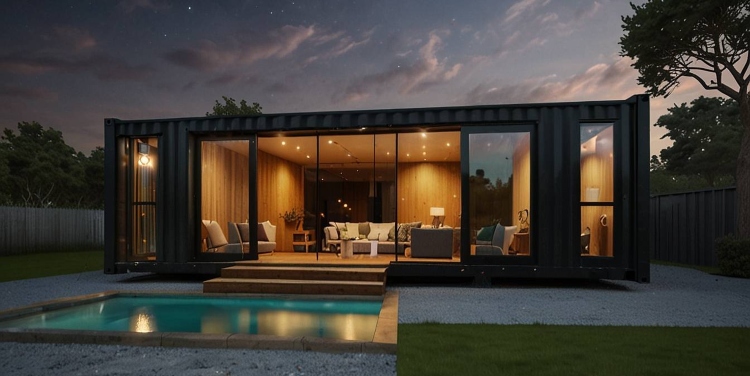Over the past decade, shipping containers have moved far beyond their initial role in global trade logistics, evolving into an exciting and practical component of modern architecture. Once used solely for transporting goods across oceans, these steel boxes are now being transformed into innovative structures that are not only affordable and sustainable but also architecturally striking. The growing popularity of containers for sale in the UK has made it easier for architects, businesses, and individuals to access these versatile units and explore their potential in construction. This article delves into how shipping containers are influencing the architectural landscape in the UK and why they are becoming a go-to option for creative, sustainable projects.
Affordable Housing Solutions
One of the most notable ways that shipping containers are being used in the UK is in the creation of affordable housing. With rising property prices and a shortage of affordable homes, many are turning to alternative solutions, and container homes have emerged as a viable option. Shipping containers are not only cost-effective but also readily available, making them an attractive choice for developers looking to create low-cost housing projects.
Container homes can be built quickly and affordably compared to traditional housing. A standard 20-foot container offers approximately 160 square feet of living space, which can be easily modified and combined with other containers to create larger, modular homes. The cost of a used shipping container can range from £1,500 to £3,000, significantly lower than the price of traditional building materials. This affordability has led to the rise of container-based housing developments across the UK, particularly in urban areas where space is limited, and the need for affordable housing is acute.
For example, the pioneering project ‘Container City’ in London’s Docklands was one of the first large-scale container housing developments in the UK. It demonstrated how multiple containers could be stacked and arranged to create multi-story, modern living spaces. This project set the stage for more container-based housing initiatives, providing a model for sustainable, affordable urban living.
Sustainable and Eco-Friendly Architecture
As sustainability becomes an increasingly important aspect of construction, shipping containers offer an eco-friendly solution for modern architecture. The use of containers helps reduce the need for new building materials, which in turn lowers the carbon footprint of construction projects. Reusing containers that have already served their purpose in the shipping industry aligns with the principles of the circular economy, where materials are repurposed rather than discarded.
According to a report by the Ellen MacArthur Foundation, construction and demolition waste account for approximately 30% of all waste produced in the UK. By repurposing shipping containers, architects and developers can significantly reduce the amount of waste generated by their projects. Additionally, container structures are highly durable, which means they can withstand extreme weather conditions and require less maintenance over time, further contributing to their sustainability.
Many container-based projects in the UK are incorporating additional eco-friendly features, such as solar panels, rainwater harvesting systems, and energy-efficient insulation. These features not only reduce the environmental impact of the buildings but also provide long-term cost savings for residents and businesses.
Modular and Flexible Design
One of the key advantages of using shipping containers in architecture is their modular nature. Containers can be easily stacked, arranged, and customized to create a wide variety of architectural forms, making them an ideal solution for projects that require flexibility. This modularity allows architects to experiment with different layouts and designs, offering endless possibilities for creating unique, multi-functional spaces.
In the UK, this versatility is being embraced in a range of settings, from commercial developments to public spaces. For example, the popular Boxpark in Shoreditch, London, is a shipping container mall that houses retail shops, food vendors, and entertainment spaces. The containers are stacked and arranged in a way that creates a dynamic and vibrant environment, allowing for quick and easy reconfiguration based on the needs of the tenants. This flexibility is particularly appealing for businesses looking for temporary or pop-up retail spaces.
Similarly, in the education and healthcare sectors, shipping containers are being used to create modular classrooms, clinics, and temporary offices. These spaces can be set up quickly and efficiently, providing an affordable solution for institutions that need additional space without the long construction times associated with traditional buildings.
Urban Revitalization and Pop-Up Culture
Shipping containers are also playing a major role in urban revitalization projects across the UK. In cities where vacant lots and underutilised spaces are common, containers offer a practical and visually appealing way to breathe new life into these areas. Container-based projects are often faster and cheaper to develop, making them a popular choice for transforming neglected urban spaces into thriving community hubs.
One notable example of this is the CARGO project in Bristol, where disused land at the city’s harbour-side was transformed into a vibrant container development featuring restaurants, cafes, and retail outlets. The project has become a popular destination for locals and tourists alike, showcasing how shipping containers can be used to create lively, attractive spaces in previously overlooked areas.
The rise of pop-up culture has also contributed to the popularity of containers in urban spaces. Pop-up restaurants, bars, and galleries made from shipping containers are becoming increasingly common, offering a temporary yet impactful presence in the urban landscape. These pop-up projects often serve as testing grounds for new business ideas, allowing entrepreneurs to experiment with their concepts before committing to a permanent location.
Architectural Aesthetic and Innovation
While shipping containers are often associated with their industrial origins, they have become a canvas for architectural innovation and creativity. Architects are increasingly experimenting with the aesthetic potential of containers, incorporating them into bold and visually striking designs that challenge traditional architectural norms. The sleek, minimalist lines of a container can be transformed into something entirely new through the use of creative cladding, paint, and window installations.
In the UK, container-based architecture is being celebrated for its innovative approach to design. The RIBA (Royal Institute of British Architects) has recognized several container projects for their excellence in architecture, highlighting their role in pushing the boundaries of what is possible with modular construction. From luxury homes to contemporary office spaces, shipping containers are proving that they can be more than just functional—they can also be beautiful.
Architects are also embracing the industrial aesthetic of containers, using their raw, rugged appearance as a design feature rather than something to hide. This trend can be seen in projects such as the Greenwich Peninsula in London, where containers are used as part of a larger mixed-use development that blends modern design with the industrial history of the area.
Conclusion
Shipping containers have come a long way from their origins as utilitarian cargo vessels, now serving as a cornerstone of modern architecture in the UK. With the growing availability of containers, architects, developers, and businesses are finding new and innovative ways to repurpose these steel structures, creating affordable, sustainable, and aesthetically pleasing spaces. As the demand for sustainable building practices continues to grow, shipping containers are likely to play an even more prominent role in shaping the future of architecture. Whether it’s transforming vacant urban spaces or providing affordable housing solutions, shipping containers are proving that they have a lasting place in the future of design and construction.
David Prior
David Prior is the editor of Today News, responsible for the overall editorial strategy. He is an NCTJ-qualified journalist with over 20 years’ experience, and is also editor of the award-winning hyperlocal news title Altrincham Today. His LinkedIn profile is here.











































































